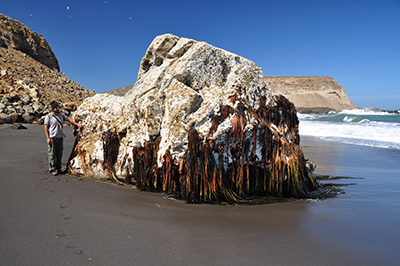Source: Geophysical Research Letters
Recently, seismologists have recognized that great subduction zone earthquakes, also known as megathrust earthquakes, tend to recur in “supercycles.” These cycles are characterized by the release of strain in a cluster of earthquakes within a few years of each other, followed by a lengthy period of quiescence ranging from several decades to several centuries, during which strain once again accumulates. Megathrust earthquakes have the potential to cause widespread damage and devastating tsunamis, yet the mechanisms that trigger two or more of these events within a few years to a decade are still not well understood, primarily because of a lack of long-term geodetic data.
Now Melnick et al. have analyzed a decade’s worth of continuously measured GPS data spanning two great earthquakes, the 2010 Maule (M 8.8) and 2015 Illapel (M 8.3) events. Both earthquakes occurred along the central Chilean margin where the Nazca plate is diving beneath the South American plate at a rate of 66 millimeters per year. The team used these data to estimate changes in surface deformation rates throughout the Andes Mountains and then compared the results with numerical simulations.

The researchers’ findings indicate that surface velocities increased following the Maule earthquake, a change they attribute to the large-scale, elastic response of both the continental and oceanic plates to fault slip during and immediately after the earthquake. This response, the team argues, accelerated the rate of shortening across the megathrust and heightened the stress on adjacent fault segments. According to the researchers, the resulting period of stress accumulation constitutes a “superinterseismic” phase of the earthquake cycle that may have brought nearby fault segments closer to failure and ultimately triggered the 2015 event.
This study demonstrates that cycles of megathrust earthquakes can be strongly influenced by the behavior of nearby seismic events. The results may help clarify the occurrence of clusters of other great earthquakes, including those that have occurred in Alaska, Cascadia, Sumatra, and Japan, as well as provide insight into the processes controlling the lag time between those events. (Geophysical Research Letters, https://doi.org/10.1002/2016GL071845, 2017)
—Terri Cook, Freelance Writer
Citation:
Cook, T. (2017), Why do great earthquakes follow each other at subduction zones?, Eos, 98, https://doi.org/10.1029/2017EO070481. Published on 31 March 2017.
Text © 2017. The authors. CC BY-NC-ND 3.0
Except where otherwise noted, images are subject to copyright. Any reuse without express permission from the copyright owner is prohibited.

